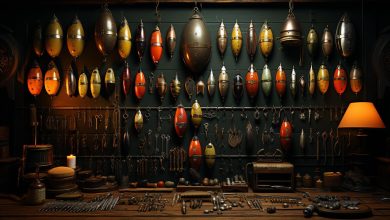Exploring Different Fishing Rigs And When To Use Them
Are you tired of casting your line and coming up empty-handed? It might be time to consider the importance of choosing the right fishing rig for the type of fish you’re trying to catch. Each rig has its own unique benefits and drawbacks, making it crucial to understand when and where each one should be used.
In this article, we’ll explore a few different fishing rigs that could help improve your chances of catching more fish. Whether you’re a seasoned angler or just starting out, understanding these rigs can make all the difference in having a successful day on the water.
So grab your tackle box and let’s get started!
Understanding the Importance of Choosing the Right Fishing Rig
You’ll want to make sure you select the appropriate rig for the specific fishing situation at hand in order to optimize your chances of success. Factors to consider when choosing a fishing rig include water depth, target species, and fishing location.
For example, if you’re fishing in shallow waters with heavy vegetation, a weedless rig may be the best option as it can prevent your bait from getting tangled up in the weeds.
Choosing the right rig can also provide benefits that lead to successful fishing. A properly selected rig can increase your chances of catching larger fish or more fish overall. It can also help reduce frustration and wasted time by ensuring that your bait is presented properly and effectively.
With this in mind, let’s take a closer look at one of the most basic fishing rigs – the traditional hook-and-line setup.
The Basic Fishing Rig
In the Basic Fishing Rig section, you’ll learn how to tie a simple yet effective rig for catching fish.
A basic fishing rig consists of a hook tied to a line with some weight attached to it. The weight keeps the bait at the desired depth and helps in casting.
There are different types of bait that can be used with this rig, such as worms, minnows, or artificial lures. Hook sizes are important when using a basic fishing rig.
The size of your hook should match the size of your bait. If your hook is too big, the fish may not bite because they’ll see it as unnatural; if it’s too small, they won’t be able to get hooked properly.
Now that you know how to tie a basic fishing rig and how to choose the right hook size and bait, let’s move on to another popular type of fishing rig – the Carolina Rig.
The Carolina Rig
Get ready to step up your fishing game with the Carolina Rig – a versatile and effective rig that’s perfect for catching a variety of fish species. The basic Carolina rig consists of a sinker, a swivel, a leader line, and a hook. However, there are different variations of the Carolina rig that you can use depending on the type of fishing scenario you find yourself in.
One advantage of using a Carolina rig is its ability to allow you to fish at different depths without changing rigs. This is because the weight of the sinker keeps your bait near the bottom while the leader line allows for some movement. Additionally, with the right setup and bait selection, you can target different species such as bass or catfish. For example, using a heavier sinker will help you get deeper down into water where larger catfish may be lurking.
Knowing which variation to use in different scenarios is key to successful fishing with this rig.
Now let’s dive into another popular fishing rig -the drop shot rig- and how it can be used effectively in various situations without having to change rigs constantly.
The Drop Shot Rig
If you’re tired of constantly switching between rigs while trying to catch different fish species, the drop shot rig is a versatile and effective option that can help you target specific depths and increase your chances of success.
The drop shot technique involves tying a hook onto your line using a Palomar knot, leaving about 12-18 inches of tag end below. Then, attach a weight (usually a tungsten or lead one) to the tag end using a simple overhand knot or specialized drop shot weight clip. This allows the bait to sit just above the weight, creating an enticing presentation for fish.
The beauty of this rig is that it allows you to keep your bait off the bottom, making it perfect for fishing in shallow water or around cover where fish might be hiding. Additionally, by adjusting the length of your tag end and choosing different weights, you can easily change how high or low your bait sits in the water column. This makes it an ideal choice for targeting suspended fish at different depths.
You can even use artificial baits such as worms or minnow imitations on this rig with great success. With all these advantages, it’s no wonder that many anglers consider this rig their go-to when fishing tricky waters.
Transitioning into the subsequent section about the jigging rig, another option for targeting deep-dwelling fish is through vertical jigging.
The Jigging Rig
Oh boy, you’re in for a treat because we’re diving into the world of jigging – the ultimate dance party for fish at different depths. Jigging is a technique that involves moving your bait up and down in the water column to attract fish. It’s an effective method for catching various species such as walleye, bass, pike, and more.
But before you start jigging away, there are some important things to consider. Firstly, selecting appropriate bait is crucial when it comes to jigging. You want to choose something that mimics the natural prey of the fish you’re targeting. This can include soft plastics like minnows or worms, or even live bait if it’s legal in your area.
Secondly, it’s essential to understand how deep the fish are located so that you can adjust your jig accordingly. Different jigs have different weights which affect how fast they sink, making it necessary to experiment with various sizes until you find what works best for your target species.
Lastly, mastering the timing of your jig is key – too slow or too fast movements may not be effective in attracting fish. Practice makes perfect when it comes to this technique!
Conclusion
Congratulations! You’ve now gained a good understanding of different fishing rigs and their uses. By choosing the right rig for the fish you’re targeting and the water conditions, you can increase your chances of a successful catch.
Did you know that according to a survey by the American Sportfishing Association, over 49 million Americans participate in recreational fishing every year? That’s a lot of anglers out there looking to hook some fish! With so many people on the water, it’s important to have knowledge and skills that set you apart as an angler.
Remember, practice makes perfect when it comes to using different fishing rigs. Don’t be afraid to experiment with new techniques and try out different combinations until you find what works best for you.
Keep learning and improving your skills, and soon enough, you’ll be reeling in those big catches like a pro!



